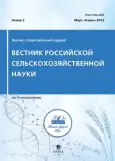Адаптация меристемных растений земляники в условиях ex vitro с применением Эмистима
- Авторы: Мацнева О.В.1, Ташматова Л.В.1, Хромова Т.М.1
-
Учреждения:
- Всероссийский научно-исследовательский институт селекции плодовых культур
- Выпуск: № 2 (2025)
- Страницы: 31-36
- Раздел: Растениеводство и селекция
- Статья опубликована: 29.05.2025
- URL: https://modernonco.orscience.ru/2500-2082/article/view/684944
- DOI: https://doi.org/10.31857/S2500208225020077
- EDN: https://elibrary.ru/HUQAVM
- ID: 684944
Цитировать
Полный текст
Аннотация
В статье представлены данные о влиянии элиситора Эмистим на процесс адаптации меристемных растений земляники садовой к нестерильным условиям. Объект изучения – микроразмноженные растения земляники шести промышленных сортов: Asia (NF 421), Darselect, Florence, Honeoye, Kimberly, Syria (NF 137). Использование раствора Эмистима на этапе высадки растений земляники in vitro в нестерильные условия позволило увеличить выход адаптированных растений по отдельным генотипам до 100%. Максимальный выход отмечали у сорта Florence при всех способах и сроках воздействия Эмистимом. В среднем по сортам биометрические показатели при всех способах обработки растений препаратом Эмистим превышали показатели контроля, сроки адаптации сокращались на 5–7 дн. Наибольшее количество листьев через 30 дн. адаптации сформировалось под действием Эмистима в течение 1 ч (6,4 ± 0,3). Длина корней через 30 дн. культивирования превышала контрольные показатели на 10–18%, 40 дн. – 15–25%. Оптимальным способом обработки растений можно считать замачивание базальной части розеток земляники в растворе Эмистима в течение 1 ч. Выявлена возможность усиления иммунитета растений земляники, полученных in vitro, на этапе адаптации к нестерильным условиям окружающей среды и при доращивании с помощью препарата нового поколения Эмистим, оказывающим положительное влияние на их рост и развитие. Результаты исследований позволяют рекомендовать данную технологию к использованию в системе массового производства качественного посадочного материала земляники.
Ключевые слова
Полный текст
Об авторах
Ольга Владимировна Мацнева
Всероссийский научно-исследовательский институт селекции плодовых культур
Автор, ответственный за переписку.
Email: macneva@orel.vniispk.ru
Россия, д. Жилина, Орловская область
Лариса Владимировна Ташматова
Всероссийский научно-исследовательский институт селекции плодовых культур
Email: macneva@orel.vniispk.ru
Кандидат сельскохозяйственных наук
Россия, д. Жилина, Орловская областьТатьяна Михайловна Хромова
Всероссийский научно-исследовательский институт селекции плодовых культур
Email: macneva@orel.vniispk.ru
Кандидат биологических наук
Россия, д. Жилина, Орловская областьСписок литературы
- Белякова Л.В., Высоцкий В.А., Алексеенко Л.В. Применение элиситоров при клональном микроразмножении земляники // Плодоводство и ягодоводство России. 2011. Т. 26. С. 194-200.
- Дорошенко Н.П., Пузырнова В.Г., Трошин Л.П. Усовершенствование технологии клонального микроразмножения винограда // «Магарач». Виноградарство и виноделие. 2022. Т. 24 (2). С. 102–111. https://doi.org/10.35547/ IM.2022.46.55.001
- Жидехина Т.В. Результаты применения биорегуляторов роста циркон, эмистим и экост на ягодных культурах // Мат. VIII межд. Симп. «Новые и нетрадиционные растения и перспективы их использования». Москва, 22–26 июня 2009 г. Т. 2. 2009. 547 с.
- Каширская Н.Я., Цуканова Е.М., Кочкина А.М. Применение препаратов из группы иммуно- и росторегуляторов в защите яблони от парши // Плодоводство и ягодоводство России. 2017. Т. 48 (2). С. 144–147.
- Кухарчик Н.В., Кастрицкая М.С., Семенас С.Э., и др. Размножение плодовых растений в культуре in vitro / Под общ. ред. Н.В. Кухарчик. Минск: Беларуская навука. 2016. 208 с.
- Мацнева О.В., Ташматова Л.В. Клональное микроразмножение земляники – перспективный метод современного питомниководства (обзор) // Современное садоводство. 2019. № 4. С. 113–119. https://doi.org/ 10.24411/2312-6701-2019-10411
- Мацнева О.В., Ташматова Л.В., Хромова Т.М. Биотехнологические приемы оптимизации микроклонального размножения и адаптации генотипов земляники садовой (Fragaria × ananassa Duch.) (методические рекомендации). Орел. ВНИИСПК. 2021. 24 с.
- Прусакова Л.Д., Малеванная Н.Н., Белопухов С.Н., Вакуленко В.В. Регуляторы роста растений с антистрессовыми и иммунопротекторными свойствами // Агрохимия. 2005. № 11. С. 76–86.
- Хапова С.А., Мальцев Д.Е. Эффективное использование регуляторов роста при культивировании ремонтантных и обычных сортов земляники в Ярославской области // Плодоводство и ягодоводство России. 2012. Т. 30. С. 119–128.
- Bulgari R., Franzoni G., Ferrante A. Biostimulants Application in Horticultural Cropsunder Abiotic Stress Conditions // Agronomy. 2019. Vol. 9. P. 306. https://doi.org/10.3390/agronomy9060306 www.mdpi.com/journal/agronomy
- Dewir Y.H., Al-Ali A.M., Al-Obeed R.S. et al. Biological Acclimatization of Micropropagated Al-Taif Rose (Rosa damascena f. trigintipetala (Diek) R. Keller) Plants Using Arbuscular Mycorrhizal Fungi Rhizophagus fasciculatus // Horticulturae. 2024. Vol. 10. P. 1120. https://doi.org/10.3390/horticulturae10101120
- El Bakouri Z. E., Meziani R., Mazri M.A. et al. Production cost of tissue cultured date palm cv. Mejhoul in Morocco: a 10-year based agribusiness study// Plant Cell, Tissue and Organ Culture (PCTOC). 2023. Vol. 152. P. 405–416. https://doi.org/10.1007/s11240-022-02417-y
- Grzelak1 M., Pacholczak A., Nowakowska K. The effect of several growth regulators and biostimulants on biochemical and physiological changes in acclimation of micropropagated Echinacea purpurea Moench. ‘Raspberry Trufe’ // Plant Cell, Tissue and Organ Culture (PCTOC). 2024. Vol. 159. No. 22. P. 1–17. https://doi.org/10.1007/s11240-024-02869-4
- Krakhmaleva I.L., Molkanova O.I., Orlova N.D. et al. In Vitro Morpho-Anatomical and Regeneration Features of Cultivars of Actinidia kolomikta (Maxim.) Maxim. // Horticulturae. 2024. Vol. 10. P. 1335. https://doi.org/10.3390/horticulturae1012133
- Kumar D., Mahadev M., Sanjeev S. et al. Tissue Culture Approaches to Strawberries Improvement // Agryculture & Food: E-Newsletter. 2024. Vol. 06. I. 08. P. 362–368. https://www.researchgate.net/publication/384241244
- Mukherjee E., Gantait S. Strawberry biotechnology: A review on progress over past 10 years // Scientia Horticulturae. 2024. Vol. 4. No. 1. P. 113618. https://doi.org/10.1016/j.scienta.2024.113618
- Samarskaya V.O., Malaeva E.V., Postnova M.V. Aspects of clonal micropropagation and conservation of plants in vitro // Natural Systems and Resources. 2019. Vol. 9. No. 3. PP. 13–22. https://doi.org/10.15688/nsr.jvolsu.2019.3.2
- Sharma N., Kumar N., James J. et al. Strategies for successful acclimatization and hardening of in vitro regenerated plants: Challenges and innovations in micropropagation techniques // Plant Science Today (Early Access). 2023. https://doi.org/10.14719/pst.2376
- Soppelsa S., Kelderer M., Casera C. et al. Foliar Applications of Biostimulants Promote Growth, Yield and Fruit Quality of Strawberry Plants Grown under Nutrient Limitation // Agronomy. 2019. Vol. 9. P. 483. https://doi.org/10.3390/agronomy9090483
- Zydlik P., Zydlik Z., Kafkas N.E. The Effect of the Foliar Application of Biostimulants in a Strawberry Field Plantation on the Yield and Quality of Fruit, and on the Content of Health-Beneficial Substances // Agronomy. 2024. Vol. 14. P. 1786. https://doi.org/10.3390/ agronomy1408178
Дополнительные файлы













